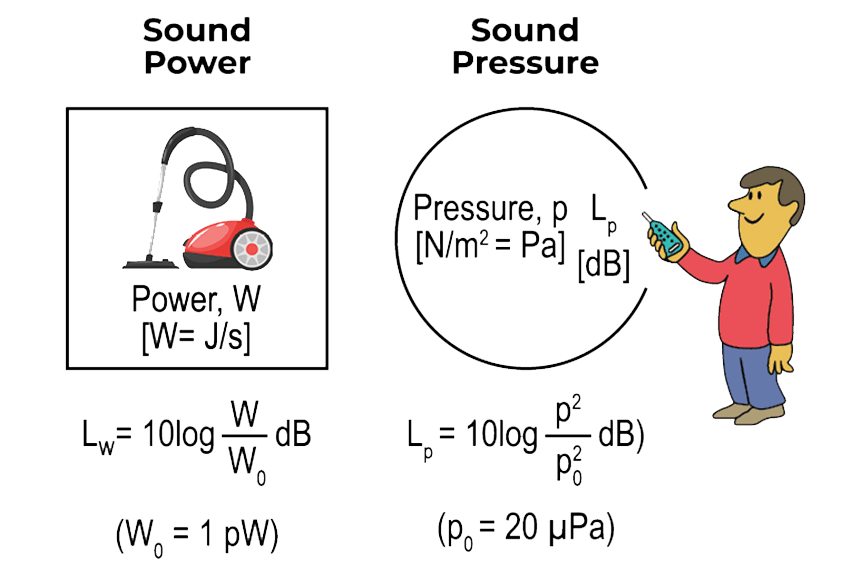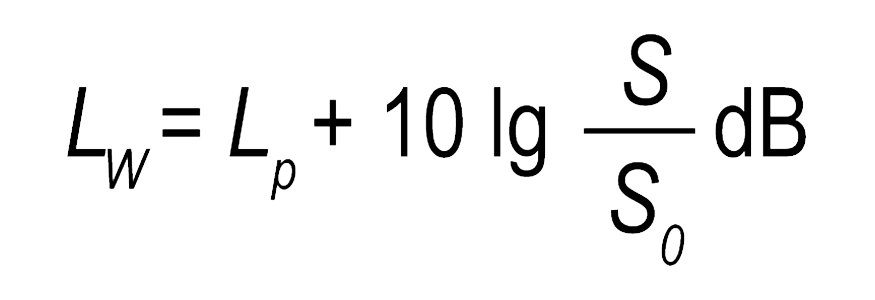Relationship between Sound Power and Sound Pressure
A simple analogy to help understand the relationship between sound power and sound pressure can be made with heat.
An electric heater has a certain power output that it radiates into a room, raising the temperature in the room. The power output of the heater is independent of the room that the heater is in. However, the temperature in the room will vary depending on our distance from the heater as well as on the characteristics of the room such as its size and how much heat is absorbed or transferred through the walls and floor of the room.
The relationship between the sound power output of a sound source and the sound pressure levels in a room is similar. The sound energy radiating from the source will raise the sound pressure level in the room. The sound power level of the source is independent of the room, but the sound pressure levels will depend on our distance from the source and the characteristics of the room.
This includes the size of the room, and how much the surfaces within the room reflect or absorb sound.
Just like with sound pressure, we normally express sound power as a level in decibels. This can sometimes be a source of confusion – particularly when the reference value is omitted. The reference value for sound pressure levels is 20 µPa, while the reference value for sound power levels is 1 pW.
These reference values have been chosen such that in a perfect free field, at a distance where the propagation area is 1 m2, the sound pressure level and sound power level are equal.
Why Determine Sound Power Levels?
Knowing the sound power level of a device is very useful. It allows us to objectively compare the sound output of different devices, without any knowledge of the environment in which they were tested or the distance at which measurements were taken.
This makes sound power levels ideal for product labeling, for specifying noise emission limits for devices, and for verifying compliance with limits.
Because sound power levels are independent of the acoustical environment and measurement location, they also allow us to calculate sound pressure level immissions from a device to specific locations in a known acoustical environment.
For example, an acoustical consultant may use the sound power level of a piece of machinery to calculate the sound pressure level it would create at a nearby residence if it were to be installed at a specific location. The consultant can then determine if the resulting noise immissions at the residence will comply with the relevant regulations, or if mitigation measures should be designed or different, quieter, machinery should be chosen.
How to Measure Sound Power
Sound power can be determined from sound pressure or sound intensity measurements.
There are two methods for determining sound power from sound pressure measurements, the direct method, and the comparison method. The direct method is most commonly used in essentially free-field environments, but it can also be used in a reverberant sound field. The comparison method, however, is only used in reverberant sound fields.
In the direct method, an imaginary surface enveloping the device under test is defined, and sound pressure measurements are made at several positions on the surface. These sound pressure level measurements are spatially averaged and corrected for the influence of the acoustical environment (such as background noise).
Once the average sound pressure level has been determined for the measurement surface. The sound power level can be calculated by simply adjusting for the ratio of the surface area to the reference surface area of 1 m2. This is where the sound power level is equal to the sound pressure level.
The comparison method is a little different. In this method, a reference sound source with a known and stable sound power level is used. Sound pressure measurements are made in the test room with both the reference sound source operating and with the device under test operating. The sound power level of the device under test can then be calculated by comparing the sound pressure levels measured with each sound source.
Determining sound power from sound intensity measurements follows a very similar process to the direct method with sound pressure measurements. But because sound intensity is a time-averaged vector quantity, it is much more tolerant of background noises and reverberation than sound pressure-based measurements. This makes sound intensity-based sound power determination particularly well suited to in situ measurements.
Sound Power Standards
There are many standards for sound power determination, catering for many different types of noise sources, measured in various acoustical environments, and achieving different levels of precision. A detailed discussion of the many standards currently in use is outside the scope of this article; however, we can provide an overview.
We can first divide into “basic standards” and “noise test codes”. Basic standards specify methods for determining sound power for all types of products in a variety of acoustical environments and accuracy levels. As a result, they only provide general advice on operating and mounting conditions for the device under test.
Noise test codes, on the other hand, are specific to particular types of noise sources and specify detailed requirements for mounting and operating conditions, as well as identifying which basic standards should be used. Generally, if a noise test code exists for a device, it should be used.
Where no noise test code exists, a basic standard can be used. ISO 3740:2019(en) Acoustics – Determination of sound power levels of noise sources – Guidelines for the use of basic standards gives an overview of basic standards for sound power determination. This can be used to select an appropriate standard, taking into account the test environment and equipment, device characteristics under test, and the desired level of accuracy.
ADVICE ON SELECTING YOUR SOLUTION
CONTACT OUR SALES ENGINEERS
Instruments for Measuring Sound Power
The most suitable instrumentation for sound power determination depends on the method and test environment chosen, as well as the volume of testing and characteristics of the source.
Brüel & Kjær has a comprehensive range of instrumentation and software for sound power determination. Below, we've listed some of the most widely applicable options.

Iscriviti alla nostra Newsletter e ricevi le informazioni più recenti dal mondo del suoni e delle vibrazioni









